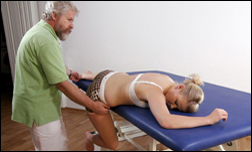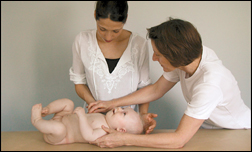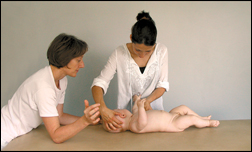Vojta Therapy
Reflex Locomotion – The Fundamentals of Vojta Therapy
The therapeutic use of reflex locomotion enables elementary patterns of movement in patients with impaired central nervous systems and locomotor system to be restored once more—at least in part—, i.e. they become accessible once more. Reflexlocomotions are activated “reflexogenically”. “Reflex”, in the sense of reflex locomotion, does not refer to the kind of the neuronal regulation, but is rather related to therapeutically applied external stimuli and their predefined and always identical, “automatically” present movement responses.
In Vojta Therapy, the therapist administers goal-directed pressure to defined zones on the body in a patient who is in a prone, supine or side lying position. In everyone—regardless of age—such stimuli lead automatically and involuntarily, i.e. without actively willed cooperation on the part of the person concerned, to two movement complexes:
Reflex creeping in a prone lying position and reflex rolling from a supine and side lying position. Reflex creeping leads to a type of creeping movement, while reflex rolling begins from a supine lying position, and transforms, via a side lying position, into the so-called quadrupedal gait.
In reflex locomotion, there is a coordinated, rhythmic activation of the total skeletal musculature and a CNS response at various circuit levels. The motor reactions, stimulated by pressure from a defined starting position and which proceed regularly and cyclically, can already be completely stimulated and reproduced as often as desired in the new-born.
All motor movements that appear in us in the development of grasping, rolling, crawling, standing up and walking are therefore activated visibly. They are – according to Prof Vojta – also already present in children, in a stage of development, in that children do not yet possess these abilities spontaneously.
Through therapeutic use of reflex locomotion, the – involuntary – muscle functions necessary for spontaneous movements in everyday life are activated in the patient, particularly in the spine, but also in the arms and legs, the hands and feet, as well as in the face.
Prof Vojta assumed that repeatedly stimulating these “reflex-like” movements lead to something like “freeing a switch” or “new networking” within functionally blocked networks of nerves between the patient’s brain and spinal cord.
Goal of the Therapeutic Use of Reflex Locomotion
Through the use of the reflex locomotion, the elementary components of man's uprighting and locomotion, i.e.
1. Equilibrium of the body when moving (“postural regulation”)
2. Uprighting of the body against gravity
3. Goal-directed grasping and stepping movements of the limbs (“phasic mobility”)
should become accessible and usable once more.
The Difference from Other Physiotherapy Techniques and Methods
In Vojta Therapy movement functions, such as grasping, rolling over from the back onto the stomach or walking, are not practised. Rather, the therapeutic activation of reflex locomotion facilitates access, via the central nervous system, to the individual segmental patterns of movement necessary for a specific movement or activity.
After Vojta treatment, these segmental patterns are more available spontaneously to the patient. Regular repetition of the “normal movement” stored in the brain prevents evasion movements being practised. In any case, these would only be a substitute for the actual, and therefore desired, “normal movement”.
Activating Vegetative and Other Automatic Reactions
With reflex locomotion, along with the “major” motor processes, also specific reactions such as:
- conjugate eye movement (oculomotor activity)
- tongue movements, jaw movements (orofacial motor activity)
as well as vegetative functions such as:
- regulation of bladder and bowel function
- breathing
- sucking and swallowing
can be activated and manipulated.
Reflex Locomotion and its Relation to Normal Motor Development
In all, the segmental patterns of reflex locomotion include all the building blocks of human motor development up to walking unaided. Through regular Vojta Therapy, the segmental patterns are “activated” in the central nervous system so that the activated state persists beyond the therapy, and the child/adult’s spontaneous movements are positively influenced.
According to clinical experience, a patient (child/adult) has a much more comprehensive—even normal—body posture after activation through reflex locomotion. This also gives the patient increasing emotional security to cope with the world around him and to build up experience.
Vojta Therapy in Childhood
Vojta Therapy can equally be used in new-born babies as in children. It is indicated on the basis of a medical diagnosis and the accordingly formulated therapy goal.
Best results are obtained when the patient has not yet developed and established any so-called substitute motor patterns. In patients with established “substitute motor activity”, the goal of treatment is to activate and maintain physiological patterns of movement, as well as to reduce non-established abnormal patterns of movement and to integrate them into normal motor processes, all the way to complete mastery of conscious motor activity.
New-Born Babies Crying in Vojta Therapy
The therapeutically desired activated state often expresses itself during treatment in new-born babies as crying. This understandably leads to parents feeling concerned, and makes them assume that it is “hurting” their child. At this age, however, crying is an important and appropriate means of expression for the little patients, who react in this way to unaccustomed activation. As a rule, after a short familiarisation period, the crying is no longer so intense, and in breaks from exercise as well as after the therapy, new-born babies calm down immediately. In older children who can express themselves in speech, crying no longer occurs.
Vojta Therapy in Adulthood
In adults with acquired impairments that handicap the peripheral and central nervous regulation of movement, Vojta Therapy can be used even in the acute phase of illness, i.e. very early, as well as in the subsequent rehabilitation.

Use of reflex creeping in adults
Vojta Therapy seeks renewed access to previously healthy patterns of movement with the goal of preventing aftereffects, such as pain, or restriction of function and strength. As a desired side effect, the treatment in progress sends out impulses that have an activating effect on the higher cortical functions (motivation, concentration, patience, speech acquisition, multi-tasking, perception and the psyche).
The overarching goal of Vojta Therapy is to reconstruct the patient’s everyday competence. That means that treatment shall enable the patient to get involved once more as best he can in all activities, family, school, work, free time and similar, as he requires.
Range of Effects for Vojta Therapy
The broad range of effects of Vojta Therapy benefits patients of every age with quite different illnesses, e.g.
-
cerebral palsy
-
spinal scoliosis
-
hip joint dysplasia and dislocation
Even in severe cerebral movement disorders, there is a markedly positive influence on and favourable change in uprighting mechanisms or support functions and the ability to communicate. Vojta Therapy can be used as standard therapy in physiotherapy for almost every movement disturbance and for numerous illnesses, e.g.:
-
disturbance in central coordination in infancy
-
movement disturbances resulting from damage to the central nervous system (incl. cerebral palsy, apoplexy, MS)
-
peripheral paralysis of the arms and legs (e.g. plexus paresis, spina bifida (split spline), paraplegia, etc.)
-
various myopathies
-
complaints and impairment of functions within the spinal column, e.g. curvature of the spine (scoliosis)
-
orthopaedic/traumatologically relevant conditions of the shoulders and the arms, the hips and the legs
-
co-treatment of malformation of the hip (hip joint dysplasia or dislocation)
-
problems in the breathing, swallowing and chewing functions
Contraindications for Vojta Therapy
Vojta Therapy should not be used in:
-
acute feverish or inflammatory conditions
-
vaccinations with live vaccines following doctor’s orders (as a rule 10 days after vaccination)
-
existing pregnancy in patients
-
certain illness, as e.g. imperfect osteogenesis, heart disease etc.
In all illnesses that impact on patient’s general condition, Vojta Therapy can be carried out for shorter sessions, depending on the tolerance level of the patient, but does not have to be ruled out.
Effects of Vojta Therapy on Patient Development and Communication
With Vojta Therapy, there is the positive change in movement coordination in grasping, uprighting against gravity, walking and speaking. As a consequence of this change, the child or adult is afterwards able to express his wishes and needs more easily and comprehensively and to fulfil them spontaneously. Patients are less frustrated, and seem happier and more balanced. Older children or adults say that after Vojta treatment they feel “lighter” when they move. Such a positive emotional basis leads to a visibly improved ability to communicate. Overall, Vojta Therapy gives the patient significantly improved possibilities for motor learning as he negotiates the world around him.
Aside from Vojta Therapy, no constant observation or corrective intervention by the parents is necessary, so the new-born baby or child can move freely and spontaneously. According to the Vojta Principle, there are no incorrect postures that could hinder the success of the treatment.
Because Vojta Therapy “activates” postural and movement functions in the new-born baby or child’s central nervous system, the improved level of movement that they reach in the required few and short daily therapy units can, as a rule, be maintained over the whole day.
As a result, this also encourages the little patient to develop self-reliance and independence from adults. This is a desired goal of the treatment. Vojta Therapy likewise encourages parents in their parental role: In daily Vojta Therapy, the child experiences physical contact and a parental guidance that conveys security. Vojta Therapy thus strengthens the parent-child relationship and leads to new, enhanced experiences for the child.
Frequency and Exercise Intensity in Vojta Therapy
Reflex locomotion is an extremely effective therapy, especially for new-born babies and infants; it is also unfamiliar and very strenuous. Like many other physiotherapies, Vojta Therapy places considerable demands on parents or caregivers.
For Vojta Therapy to be successful, it should as a rule be performed several times a day on new-born babies and infants. A therapy session lasts between five and twenty minutes.
Duties of Parents/Caregivers in Vojta Therapy
Since parents or caregivers perform the therapy several times a day, they play a decisive role in Vojta Therapy.
In the treatment of adult patients, Vojta Therapy can be performed by a spouse, life partner or someone close. In this instance, therapy is, as a rule, performed several times a week.
Instruction and Performance of Vojta Therapy
As well as the primary illness, exercise intensity and accuracy determine the effectiveness and ultimately the success of the Vojta treatment. After referral to Vojta Therapy by the doctor, the Vojta therapist draws up an individual programme and determines the goals of therapy jointly with the patient/parents. The therapy programme is then determined at regular intervals in accordance with the patient’s development.


Precise instruction from the Vojta therapist reassures the mother about treating her child at home
Parents or caregivers are as a rule promptly instructed in how to perform Vojta Treatment so that therapy on the patient can be started at home and that the necessary treatment intensity is ensured.
Regardless of age, the patient is then expected regularly at the Vojta physiotherapist’s outpatient clinic.
Vojta Therapy in Interdisciplinary Treatment Teams
Prof Vojta saw improvement in automatically regulated body posture as a basic prerequisite for progress in the patient’s receptivity, perception, speech, learning etc. Thus, Vojta Therapy improves the requirements for special educational, logopaedic, occupational and other kinds of therapy. The Vojta Therapy has, therefore, an important, fundamental place in interdisciplinary treatment teams.
How can the effectiveness of Vojta Therapy be proven?
Vojta Therapy has proved itself worldwide in many patients ranging from new-born babies to adults. Reflex locomotion, as observed by Prof Vojta, its effects and therapeutic successes have been scientifically tested many times and empirically confirmed. There have moreover been isolated evidence-based studies.
Examinations into the Psychological Effects of Vojta Therapy
The suspected negative effects of Vojta Therapy, especially the psychological ones, on sensomotor development and communicative and social behaviour in new-born babies or children treated have been examined by various authors. They placed particular attention on the comparison with untreated or differently treated children as well as the effects on the mother-child relationship. These studies showed, however, that Vojta Therapy entails no negative effects from a psychological point of view, but rather that it can also have a positive effect on the psychological level.
Who administers Vojta Therapy and Diagnostics?
A qualified team of teaching physiotherapists and doctors joined forces in the International Vojta Society (IVS). This team, part of which was actually trained by Prof Vojta himself, has trained qualified Vojta therapists and doctors for more than 40 years throughout the whole world; they then for their part can officially treat patients with Vojta Therapy. Since Vojta Therapy is performed to a large extent by parents at home, it is very affordable.
Training Vojta Therapists and Doctors
Approved Vojta physiotherapists have successfully completed a professional qualification course in Vojta Therapy complying with the standards and guidelines of the International Vojta Society (IVS), eight weeks for the treatment of new-born babies and children, six weeks for the treatment of adults.
To be eligible for this qualification, candidates must have completed training as physiotherapist or doctor and have at least two years professional experience, preferably with neurologically exceptional new-born babies, children or adults.
As well as these qualification courses, there are one-week further-training courses for doctors in the neurological examination of new-born babies and infants according to Vojta Diagnostics.
Vojta training for physiotherapists and doctors following the standards and guidelines of the International Vojta Society is recommended and recognised in Germany by the leading health insurance companies.
Further Professional Training for Doctors and Vojta Physiotherapists
As well as the above qualification courses for physiotherapists, there are one-week further-training courses for doctors in neurological examination of new-born babies and infants according to Vojta Diagnostics.
The International Vojta Society (IVS), in cooperation with various clinics and institutions in Germany and other countries, regularly offers Vojta refresher courses and Vojta workshops for Vojta therapists and doctors in special topics concerning Vojta Therapy and Diagnostics.
Moreover, in Germany in collaboration with the professional associations for physiotherapists (the ZVK e.V. and IFK e.V.), the International Vojta Society (Internationale Vojta Gesellschaft e.V. /IVG) offers Vojta therapists possibilities for further training with case presentations and supervision by Vojta teaching therapists from the IVS in around 70 Vojta study groups (with around 1600 trained Vojta therapists), several times a year.








